Assessment of the Latest GPM-Era High-Resolution Satellite Precipitation Products by Comparison with Observation Gauge Data over the Chinese Mainland
Abstract
:1. Introduction
2. Dataset
2.1. Ground Reference Data
2.2. GPM-Era Satellite-Based Precipitation Datasets
3. Methodology
3.1. Statistical Assessment Metrics
3.2. Categorical Verification Metrics
3.3. Extreme Precipitation Indices
4. Results and Discussion
4.1. Summary of Satellite-Based Precipitation Product Performance over the Chinese Mainland
4.2. Twenty-Month Spatial Daily Mean Precipitation
4.3. Monthly Time Series Precipitation Analysis
4.4. Probability Distribution by Occurrence
4.5. Extreme Precipitation Events Comparison
4.6. Discussion
5. Conclusions
- In terms of ME, RMSE, CC, and POD, GSMap-Gauge showed better performance at estimating precipitation than GPM IMERG. The Taylor diagram visually demonstrated that GSMap-Gauge results are nearer to the observed values. In a spatial sense, GSMap-Gauge exhibited the best correlation over most of China (almost 90% of CC values were greater than 0.6 and about half of them were greater than 0.8). Both products were capable of capturing the overall spatial pattern of the 20 month mean daily precipitation, although they performed poorly over the arid and semiarid inland region in northwestern China. All products tended to underestimate precipitation significantly in some mountainous region, such as the southeastern Tibetan Plateau. GSMap-Gauge resulted in a spatial precipitation distribution pattern that was closer to CGDPA than GPM IMERG;
- GSMap-Gauge exhibited very stable performance when analyzed on a monthly basis, with CC values indicating no significant seasonal variation. The pattern of monthly mean CC and POD for GPM IMERG showed seasonally-dependent variability, with relatively low values in winter. In terms of CC, RMSE, and POD, GSMap-Gauge performance was more stable and generally improved over GPM IMERG. GPM IMERG overestimated monthly precipitation during the rainy season; however, GSMap-Gauge showed the completely opposite trend by underestimating monthly precipitation in summer;
- About 77% of events were reported by the observation gauge dataset to belong to no rain or light rainfall events (≤1 mm/day) during the 20 month study period. GPM IMERG produced a similar number of no rain and light rain events to the observation gauge dataset, with only a 1% overestimation. The GSMap-Gauge greatly underdetected the occurrence of no rain and light rain events (about 10% lower than observations). GPM IMERG performance for capturing precipitation events in the range of 1–16 mm/day was clearly variable, both overestimating and underestimating events at times. GSMap products captured more precipitation events within the precipitation range of 1–16 mm/day and showed slight underestimation of precipitation events of more than 32 mm/day;
- Both products captured the four indices (RR99P, RR95P, R20mm, and R20mmTOT) well with high correlation coefficients (>0.8). GPM IMERG tended to overestimate these four indices, with RB values of 9.81%, 5.68%, 4.67% and 10.1%, respectively. On the contrary, GSMap-Gauge showed significant underdetection of these indices, even when CC values were greater than 0.92. GSMap-Gauge significantly overestimated CWD, with RB around 63.6%. For CDD, GPM IMERG and GSMap-Gauge provided similar results.
Supplementary Materials
Acknowledgments
Author Contributions
Conflicts of Interest
References
- Kidd, C.; Huffman, G. Global Precipitation measurement. Meteorol. Appl. 2011, 18, 334–353. [Google Scholar] [CrossRef]
- Su, Z.; Fernandez-Prieto, D.; Timmermans, J.; Chen, X.; Hungershoefer, K.; Roebeling, R.; Schroder, M.; Schulz, J.; Stammes, P.; Wang, P.; et al. Wolters First results of the earth observation Water Cycle Multi-Mission Observation Strategy (WACMOS). Int. J. Appl. Earth. Obs. Geoinf. 2014, 26, 270–285. [Google Scholar] [CrossRef]
- Ning, S.; Ishidaira, H.; Udmale, P.; Ichikawa, Y. Remote Sensing Based Analysis of Recent Variations in Water Resources and Vegetation of a Semi-Arid Region. Water 2015, 7, 6039–6055. [Google Scholar] [CrossRef] [Green Version]
- Anagnostou, E.N.; Maggioni, V.; Nikolopoulos, E.; Meskele, T.; Hossain, F.; Papadopoulos, A. Bench marking high-resolution global satellite rainfall products to radar and rain-gauge rainfall estimates. IEEE Trans. Geosci. Remote Sens. 2010, 48, 1667–1183. [Google Scholar] [CrossRef]
- Buarque, D.C.; De Paiva, R.C.D.; Clarke, R.T.; Mendes, C.A.B. A comparison of amazon rainfall characteristics derived from TRMM, CMORPH and the Brazilian national rain gauge network. J. Geophys. Res. Atmos. 2011, 116. [Google Scholar] [CrossRef]
- Chen, S.; Hong, Y.; Cao, Q.; Kirstetter, P.-E.; Gourley, J.J.; Qi, Y.; Zhang, J.; Howard, K.; Hu, J.; Wang, J. Performance evaluation of radar and satellite rainfalls for typhoon Morakot over Taiwan: Are remote-sensing products ready for gauge denial scenario of extreme events? J. Hydrol. 2013, 506, 4–13. [Google Scholar] [CrossRef]
- Hong, Y.; Chang, N.B. Hodges Global precipitation estimation and applications. In Multiscale Hydrologic Remote Sensing: Perspectives and Applications; CRC Press: Boca Raton, FL, USA, 2012. [Google Scholar]
- Hou, A.Y.; Kakar, R.K.; Neeck, S.; Azarbarzin, A.A.; Kummerow, C.D.; Kojima, M.; Oki, R.; Nakamura, K.; Iguchi, T. The Global Precipitation Measurement Mission. Bull. Am. Meteorol. Soc. 2014, 95, 701–722. [Google Scholar] [CrossRef]
- Kummerow, C.; Hong, Y.; Olson, W.; Yang, S.; Adler, R.; McCollum, J.; Ferraro, R.; Petty, G.; Shin, D.B.; Wilheit, T. The evolution of the Goddard Profiling Algorithm (GPROF) for rainfall estimation from passive microwave sensors. J. Appl. Meteorol. 2001, 40, 1801–1820. [Google Scholar] [CrossRef]
- Wilheit, T.T.; Chang, A.T.C.; Chiu, L.S. Retrieval of monthly rainfall indices from microwave radiometric measurements using probability distribution functions. J. Atmos. Ocean. Technol. 1991, 8, 118–136. [Google Scholar] [CrossRef]
- Huffman, G.J.; Bolvin, D.T.; Neklin, E.J.; Wolff, D.B.; Adler, R.F.; Gu, G.J.; Hong, Y.; Bowman, K.P.; Stocker, E.F. The TRMM Multisatellite Precipitation Analysis (TMPA): Quasi-global, multiyear, combined-sensor precipitation estimates at fine scales. J. Hydrometeorol. 2007, 8, 38–55. [Google Scholar] [CrossRef]
- Joyce, R.J.; Janowiak, J.E.; Arkin, P.A.; Xie, P. CMORPH: A method that produces global precipitation estimates from passive microwave and infrared data at high spatial and temporal resolution. J. Hydrometeorol. 2004, 5, 487–503. [Google Scholar] [CrossRef]
- Sorooshian, S.; Hsu, K.L.; Gao, X.; Gupta, H.V.; Imam, B.; Braithwaite, D. Braithwaite 2000: Evaluation of PERSIANN system satellite-based estimates of tropical rainfall. Bull. Am. Meteorol. Soc. 2000, 81, 2035–2046. [Google Scholar] [CrossRef]
- Hong, Y.; Hsu, K.L.; Sorooshian, S.; Gao, X. Precipitation estimation from remotely sensed imagery using an artificial neural network cloud classification system. J. Appl. Meteorol. 2004, 43, 1834–1852. [Google Scholar] [CrossRef]
- Turk, F.J.; Miller, S.D. Toward improved characterization of remotely sensed precipitation regimes with MODIS/AMSR-E blended data techniques. IEEE Trans. Geosci. Remote Sens. 2005, 43, 1059–1069. [Google Scholar] [CrossRef]
- Kubota, T.; Shige, S.; Hashizume, H.; Ushio, T.; Aonashi, K.; Kachi, M.; Okamoto, K. Global precipitation map using satellite-borne microwave radiometers by the GSMaP Project: Production and validation. IEEE Trans. Geosci. Remote Sens. 2007, 45, 2259–2275. [Google Scholar] [CrossRef]
- Sharifi, E.; Steinacker, R.; Saghafian, B. Assessment of GPM-IMERG and Other Precipitation Products against Gauge Data under Different Topographic and Climatic Conditions in Iran: Preliminary Results. Remote Sens. 2016, 8, 135. [Google Scholar] [CrossRef]
- Tang, G.; Zeng, Z.; Long, D.; Guo, X. Statistical and Hydrological Comparisons between TRMM and GPM Level-3 Products over a Midlatitude Basin: Is Day-1 IMERG a Good Successor for TMPA 3B42V7? J. Hydrometeorol. 2016, 17, 121–136. [Google Scholar] [CrossRef]
- Scheel, M.L.M.; Rohrer, M.; Huggel, C.; Villar, D.S.; Silvestre, E.; Huffman, G.J. Evaluation of TRMM Multi-satellite Precipitation Analysis (TMPA) performance in the Central Andes region and its dependency on spatial temporal resolution. Hydrol. Earth Syst. Sci. 2011, 15, 2649–2663. [Google Scholar] [CrossRef] [Green Version]
- Shen, Y.; Xiong, A.; Wang, Y.; Xie, P. Performance of high-resolution satellite precipitation products over China. J. Geophys. Res. Atmos. 2010, 115. [Google Scholar] [CrossRef]
- Shen, Y.; Xiong, A. Validation and comparison of a new gauge-based precipitation analysis over mainland China. Int. J. Climatol. 2016, 36, 252–265. [Google Scholar] [CrossRef]
- Tozer, C.R.; Kiem, A.S.; Verdon-Kidd, D.C. On the uncertainties associated with gridded rainfall data as a proxy for observed. Hydrol. Earth Syst. Sci. 2012, 16, 1481–1499. [Google Scholar] [CrossRef]
- King, A.D.; Alexander, L.V.; Donat, M.G. The efficiency of using gridded data to examine extreme rainfall characteristics: A case study for Australia. Int. J. Climatol. 2013, 33, 2376–2387. [Google Scholar] [CrossRef]
- Huffman, G.J.; Bolvin, D.T.; Braithwaite, D.; Hsu, K.; Joyce, R. Algorithm Theoretical Basis Document (ATBD) Version 4.5: NASA Global Precipitation Measurement (GPM) Integrated Multi-Satellite Retrievals for GPM (IMERG); NASA: Greenbelt, MD, USA, 2015.
- Huffman, G.J.; Bolvin, D.T.; Nelkin, E.J. Day 1 IMERG Final Run Release Notes; NASA Goddard Earth Sciences Data and Information Services Center: Greenbelt, MD, USA, 2015.
- Okamoto, K.; Takahashi, N.; Iwanami, K.; Shige, S.; Kubota, T. High precision and high resolution global precipitation map from satellite data. In Conference: Microwave Radiometry and Remote Sensing of the Environment, Florence, Italy, 11–14 April 2008.
- Aonashi, K.; Awaka, J.; Hirose, M.; Takayabu, Y. GSMaP passive microwave precipitation retrieval algorithm: Algorithm description and validation. J. Meteorol. Soc. Jpn. 2009, 87A, 119–136. [Google Scholar] [CrossRef]
- Ushio, T.; Sasashige, K.; Kubota, T.; Morimoto, T. A Kalman filter approach to the Global Satellite Mapping of Precipitation (GSMaP) from combined passive microwave and infrared radiometric data. J. Meteorol. Soc. Jpn. 2009, 87A, 137–151. [Google Scholar] [CrossRef]
- Xie, P.; Yatagai, A.; Chen, M.; Hayasaka, T.; Fukushima, Y.; Liu, C.; Yang, S. A gauge-based analysis of daily precipitation over East Asia. J. Hydrometeorol. 2007, 8, 607–626. [Google Scholar] [CrossRef]
- Biondi, D.G.; Freni, V.; Iacobellis, G.; Mascaro, A. Montanari Validation of hydrological models: Conceptual basis, methodological approaches and a proposal for a code of practice. Phys. Chem. Earth 2012, 42–44, 70–76. [Google Scholar] [CrossRef]
- Tank, A.M.G.K.; Zwiers, F.W.; Zhang, X. Guidelines on Analysis of Extremes in a Changing Climate in Support of Informed Decisions for Adaptation. In Climate Data and Monitoring; World Meteorological Organization: Geneva, Switzerland, 2009. [Google Scholar]
- Miao, C. Evaluation of the PERSIANN-CDR Daily Rainfall Estimates in Capturing the Behavior of Extreme Precipitation Events over China. J. Hydrometeorol. 2015, 17, 1387–1395. [Google Scholar] [CrossRef]
- Qin, Y.; Chen, Z.; Shen, Y.; Zhang, S.; Shi, R. Evaluation of Satellite Rainfall Estimates over the Chinese Mainland. Remote Sens. 2014, 6, 11649–11672. [Google Scholar] [CrossRef]
- Tian, Y.; Peters-Lidard, C.D.; Adler, R.F.; Kubota, T.; Ushio, T. Evaluation of GSMap precipitation estimates voer the contiguous United States. J. Hydrometeorol. 2010, 11, 566–574. [Google Scholar] [CrossRef]
- Dinku, T.; Chidzambwa, S.; Ceccato, P.; Connor, S.J. Validation and intercompariosn of satellite rainfall estimates over Colobia. J. Appl. Meteorol. Climatol. 2010, 49, 1004–1014. [Google Scholar] [CrossRef]
- Guo, H.; Chen, S.; Bao, A.; Hu, J.; Yang, B.I.; Phillip, M. Stepanian Comprehensive Evaluation of High-Resolution Satellite-Based Precipitation Products over China. Atmosphere 2016, 7, 6. [Google Scholar] [CrossRef]
- Guo, H.; Chen, S.; Bao, A.; Hu, J.; Gebregiorgis, A.S.; Xue, X.; Zhang, X. Inter-comparison of High-Resolution Satellite Precipitation Products over Central Asia. Remote Sens. 2015, 7, 7181–7211. [Google Scholar] [CrossRef]
- Dinku, T.; Chidzambwa, S.; Ceccato, P.; Connor, S.J.; Ropelewski, C.F. Validation of high-resolution satellite rainfall products over complex terrain. Int. J. Remote Sens. 2008, 29, 4097–4110. [Google Scholar] [CrossRef]
- Li, X.; Zhang, Q.; Xu, C.Y. Assessing the performance of satellite-based precipitation products and its dependence on topography over Poyang Lake basin. Theor. Appl. Climatol. 2014, 115, 713–729. [Google Scholar] [CrossRef]
- Qi, W.; Zhang, C.; Fu, G.; Sweetapple, C.; Zhou, H. Evaluation of global fine-resolution precipitation products and their uncertainty quantification in ensemble discharge simulations. Hydrol. Earth Syst. Sci. 2016, 20, 903–920. [Google Scholar] [CrossRef] [Green Version]
- Prakash, S.; Mitra, A.K.; Pai, D.S.; Aghakouchak, A. From TRMM to GPM: How well can heavy rainfall be detected from space? Adv. Water Resour. 2016, 88, 1–7. [Google Scholar] [CrossRef]
- Zhong, L. Comparison of integrated multisatellite retrieval for GPM (IMERG) and TRMM multisatellite precipitation analysis (TMPA) monthly precipitation products: initial results. J. Hydrometeorol. 2016, 17, 777–790. [Google Scholar]
- Maussion, F.; Scherer, D.; Molg, T.; Collier, E.; Curio, J.; Finkelnburg, R. Precipitation seasonality and variability over the Tibetan Plateau as resolved by the High Asia Reanalysis. J. Clim. 2014, 27, 1910–1927. [Google Scholar] [CrossRef]
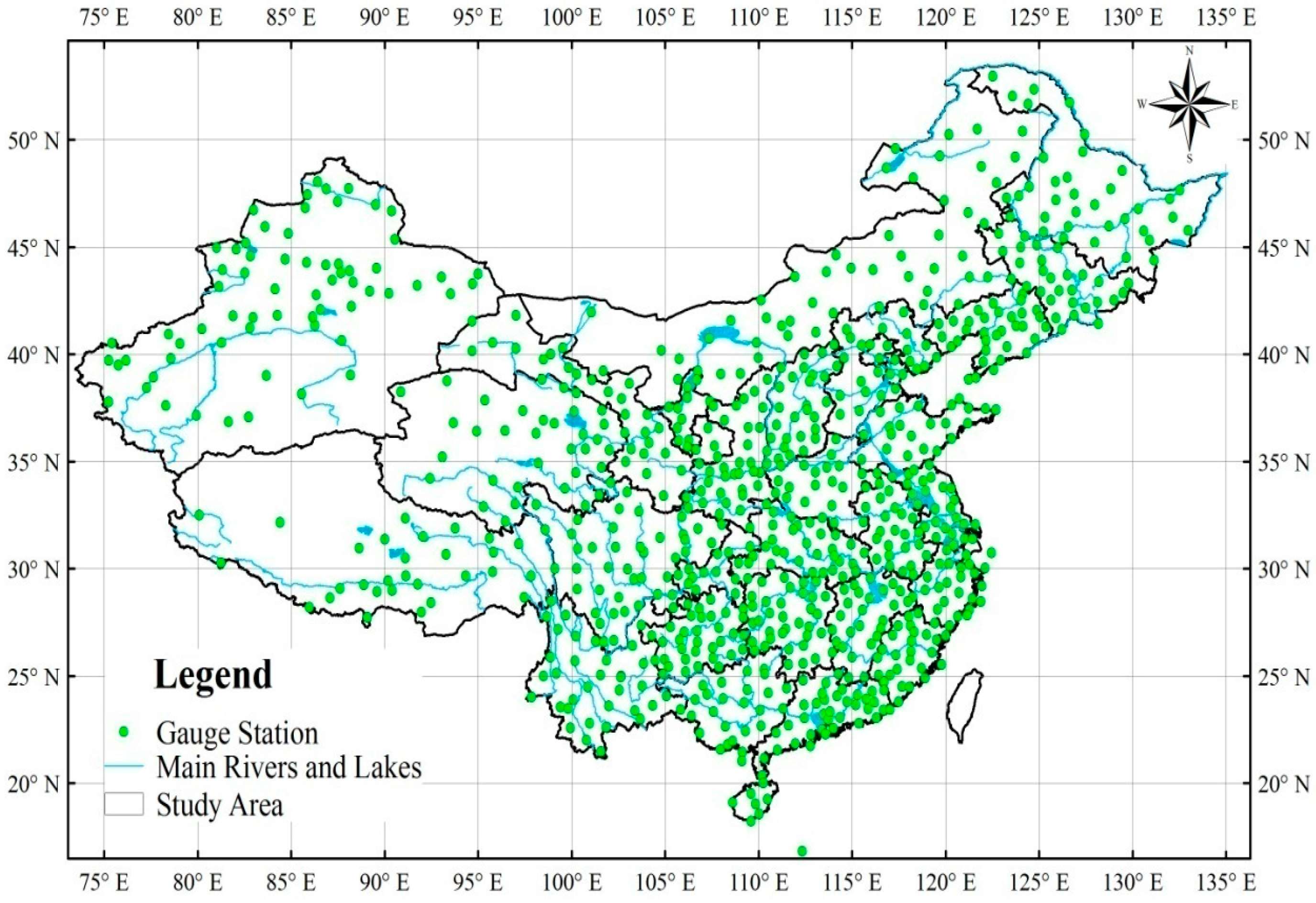
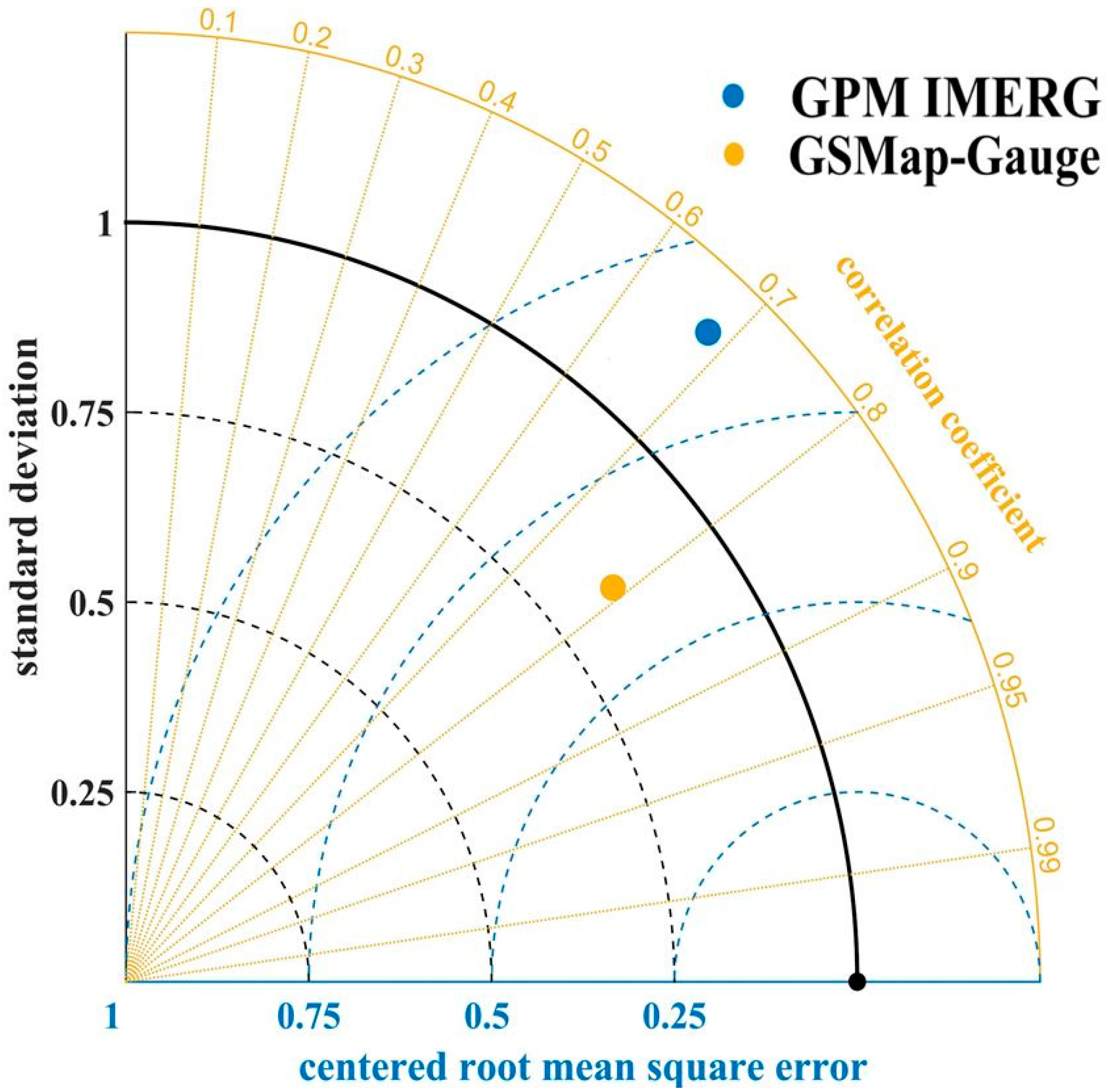

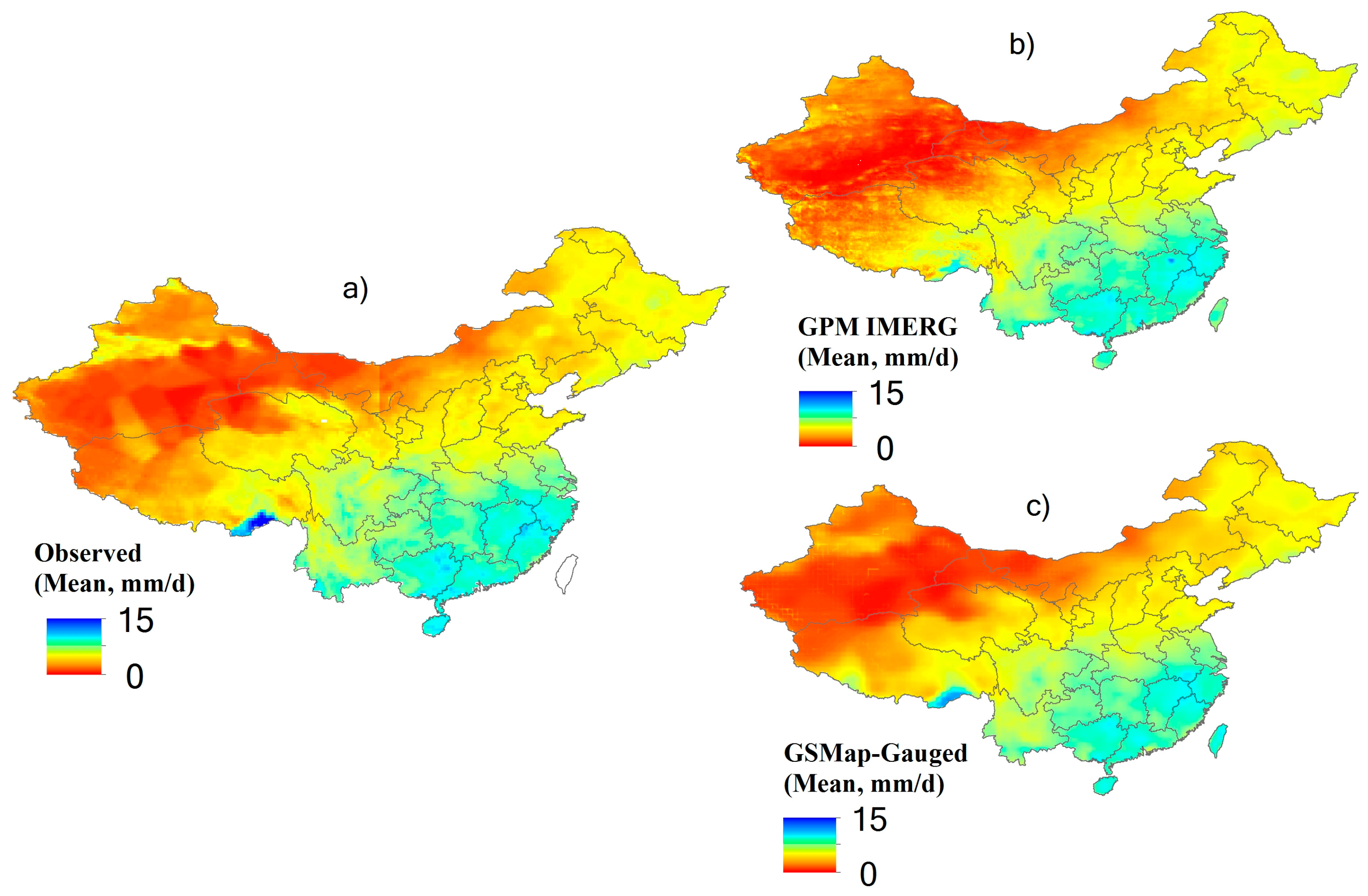
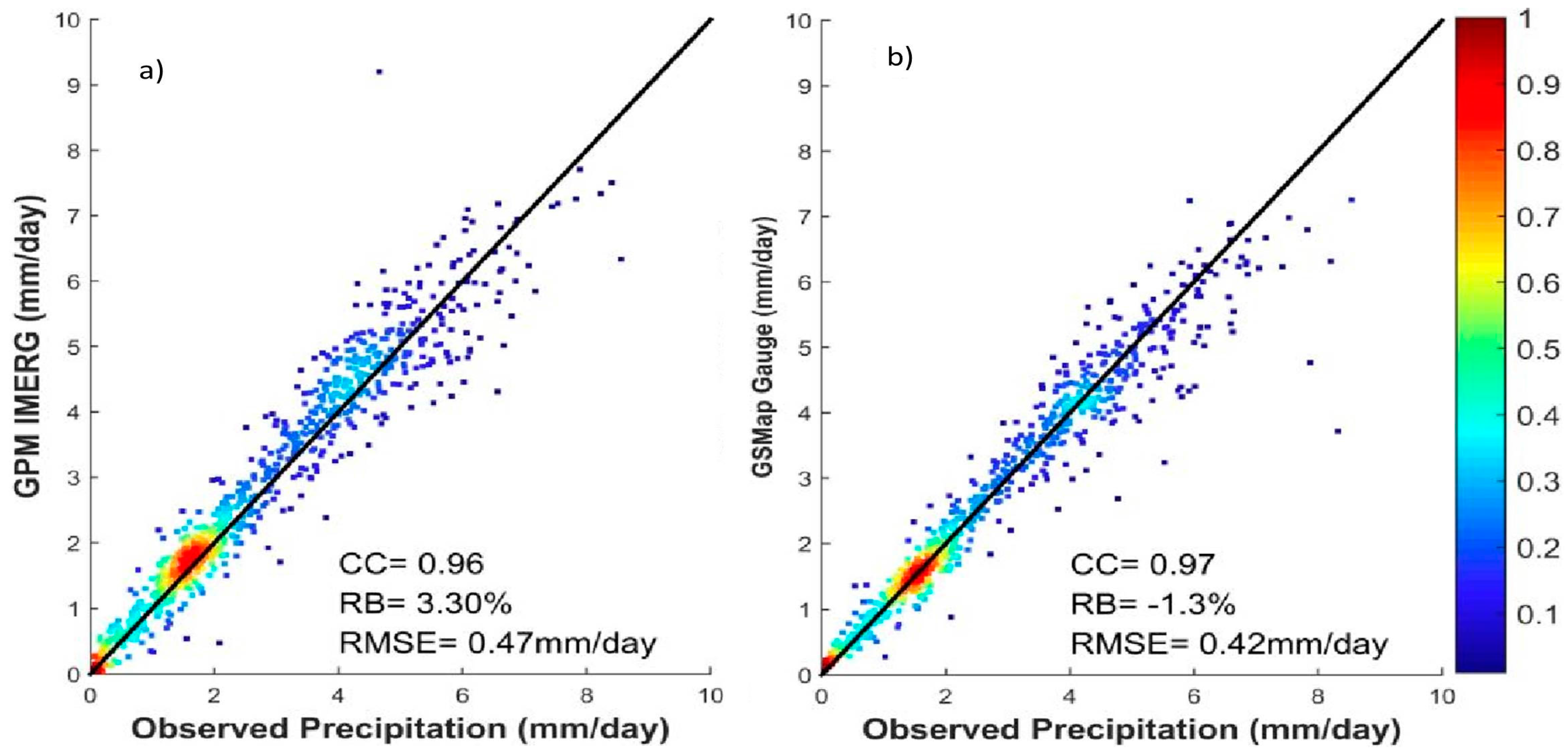
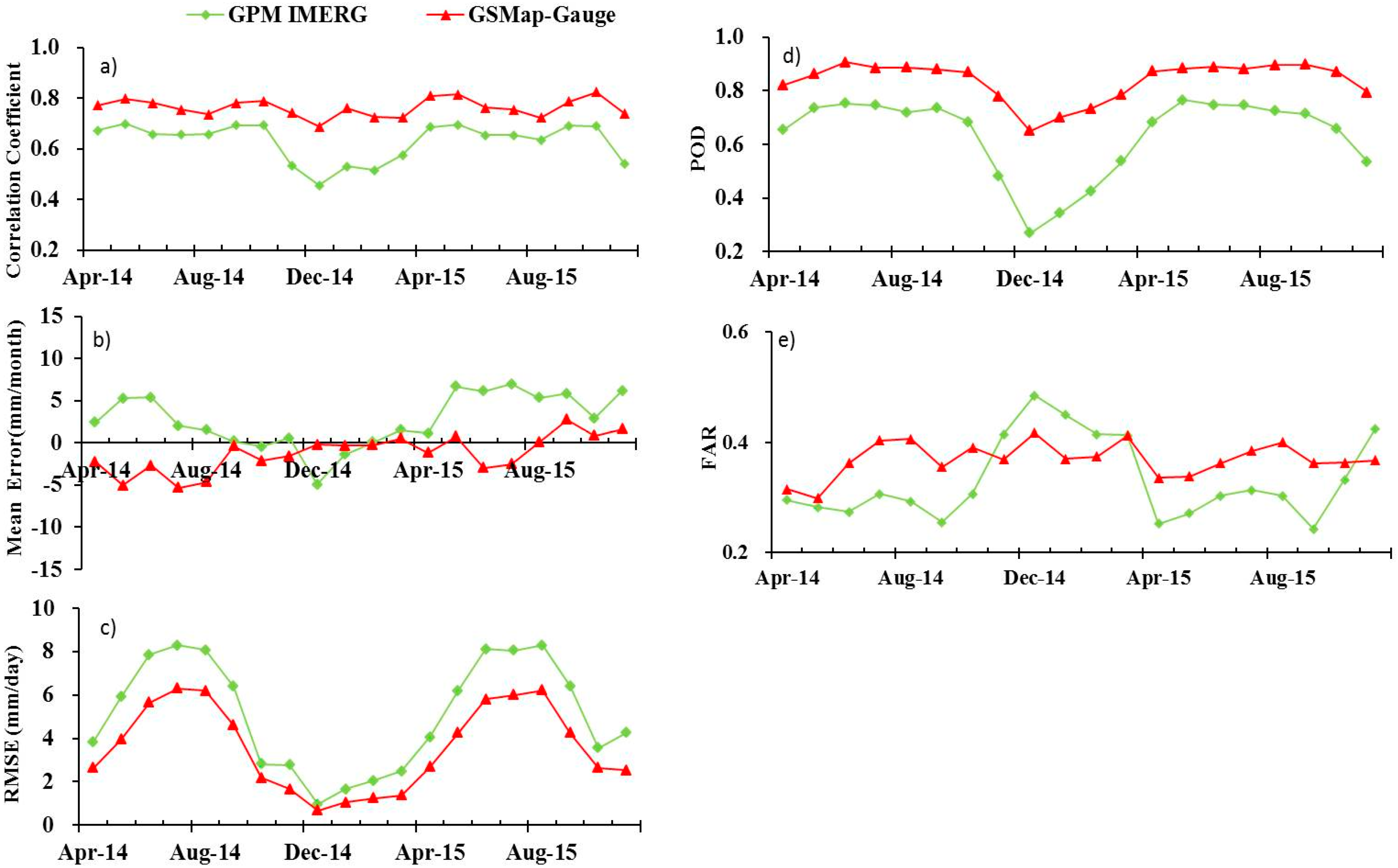
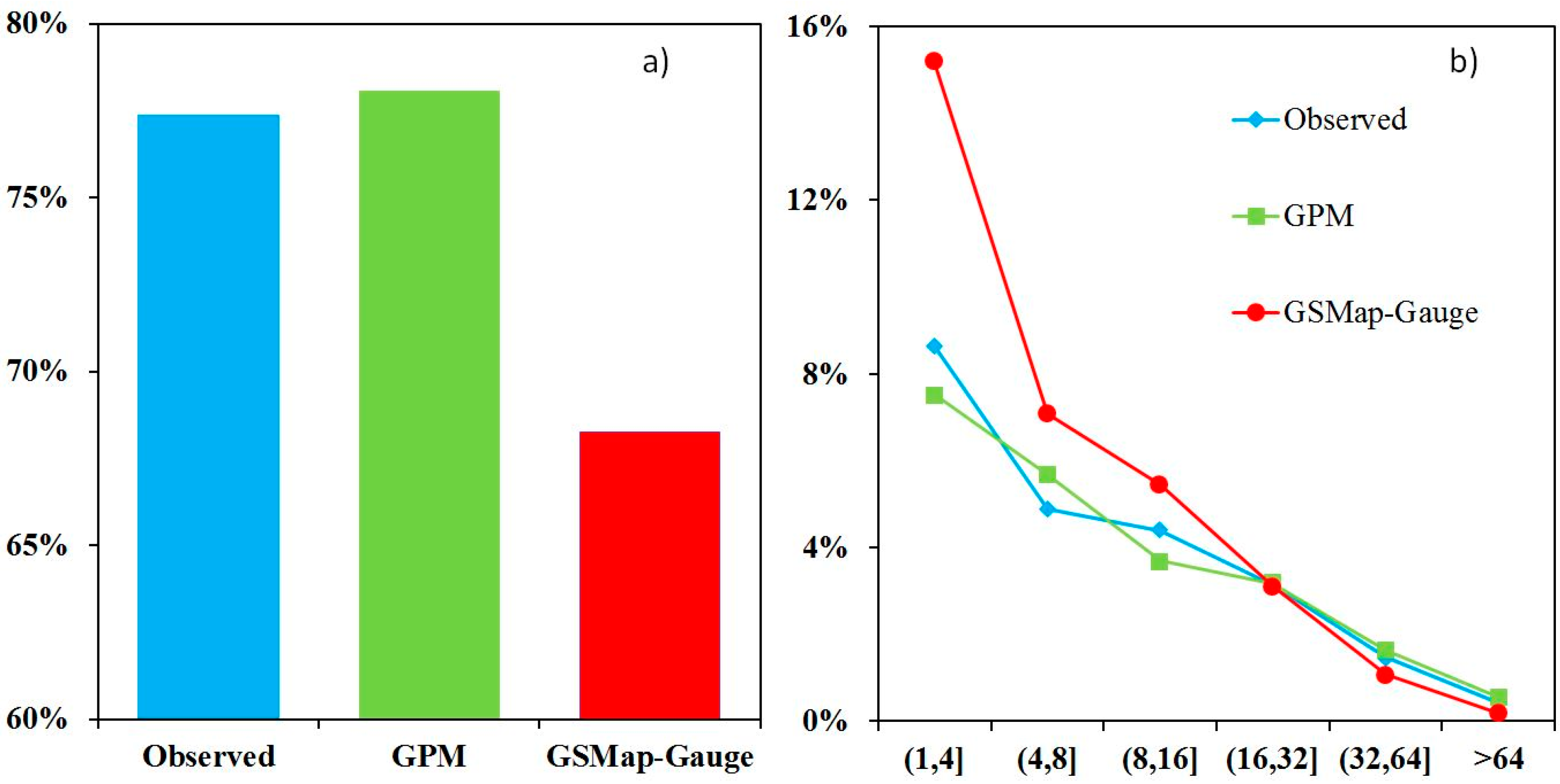
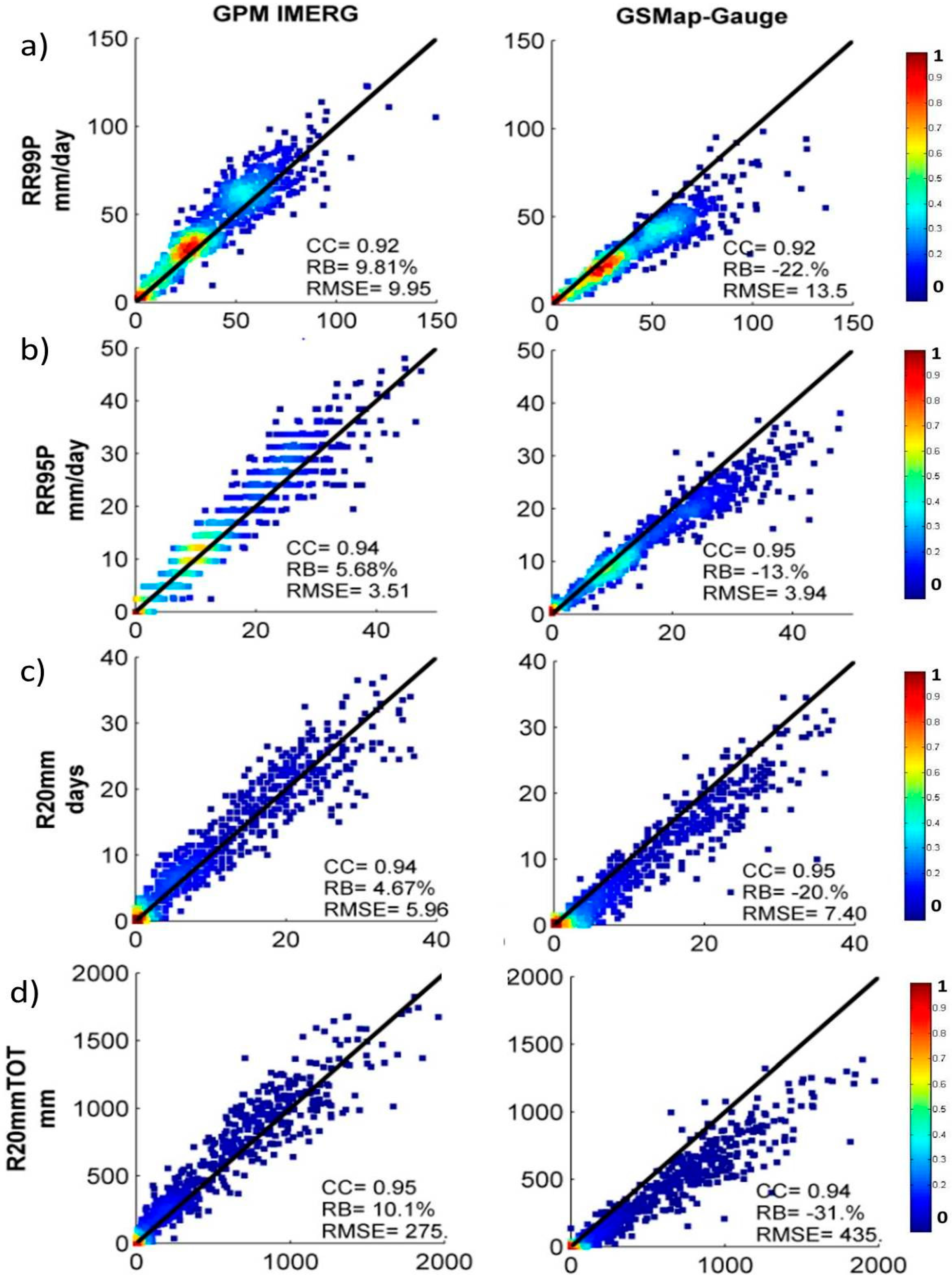
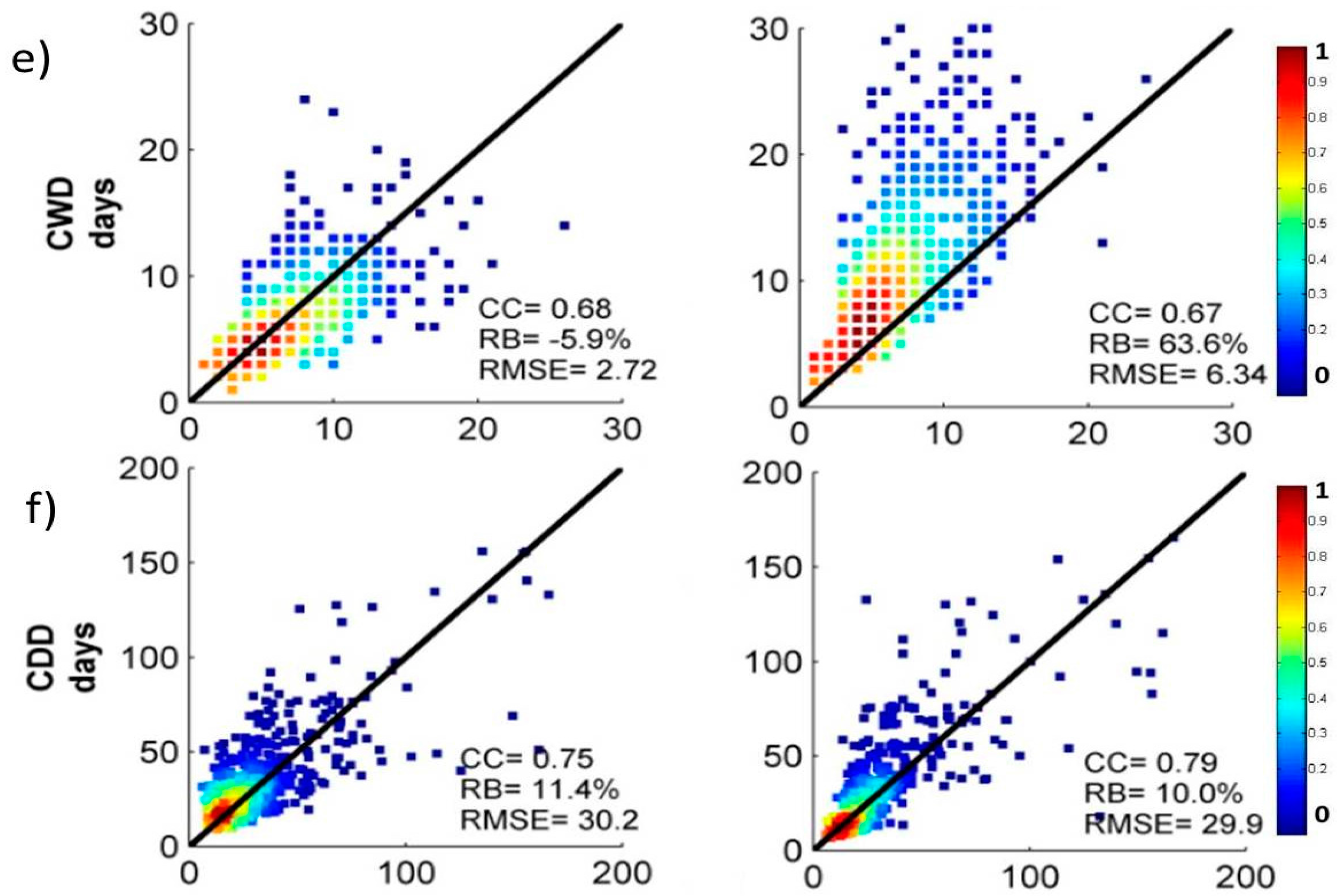
| Name | Temporal Resolution | Spatial Resolution | Region | Period | Corrected by Gauges |
|---|---|---|---|---|---|
| GPM IMERG | 0.5 h | 0.1° | 60° N–S | from Mar. 2014 | Yes (GPCC monthly) |
| GSMap-Gauge (ver. 6) | 1 h | 0.1° | 60° N–S | from Mar. 2014 | Yes (CPC daily) |
| Statistic Metric | Equation | Perfect Value |
|---|---|---|
| Correlation Coefficient (CC) | 1 | |
| Mean Error (ME) | 0 | |
| Relative Bias (RB) | 0 | |
| Root Mean Square Error (RMSE) | 0 |
| Satellite Products | ||
|---|---|---|
| Rain Gauge | Yes | No |
| Hits (a) | Misses (c) | |
| False alarms (b) | Correct negative (d) | |
| Category | ID | Definition | Unit |
|---|---|---|---|
| Percentile indices | RR99p | The 99th percentile of daily precipitation on wet days (Pre. ≥1 mm) | mm/day |
| RR95p | The 95th percentile of daily precipitation on wet days | mm/day | |
| Absolute threshold indices | R20mm | Annual count of days when daily precipitation is ≥20 mm | days |
| R20mmTOT | Annual total precipitation when daily precipitation is ≥20 mm | mm/day | |
| Max indices | CWD | Annual largest number of consecutive days with daily precipitation ≥1 mm | days |
| CDD | Annual largest number of consecutive days with daily precipitation <1 mm | days |
| Name | ME (mm/Day) | RMSE (mm/Day) | CC | POD | FAR |
|---|---|---|---|---|---|
| GPM IMERG | 0.09 | 6.43 | 0.68 | 0.79 | 0.30 |
| GSMap-Gauge (ver. 6) | −0.04 | 4.70 | 0.79 | 0.87 | 0.37 |
© 2016 by the authors; licensee MDPI, Basel, Switzerland. This article is an open access article distributed under the terms and conditions of the Creative Commons Attribution (CC-BY) license (http://creativecommons.org/licenses/by/4.0/).
Share and Cite
Ning, S.; Wang, J.; Jin, J.; Ishidaira, H. Assessment of the Latest GPM-Era High-Resolution Satellite Precipitation Products by Comparison with Observation Gauge Data over the Chinese Mainland. Water 2016, 8, 481. https://doi.org/10.3390/w8110481
Ning S, Wang J, Jin J, Ishidaira H. Assessment of the Latest GPM-Era High-Resolution Satellite Precipitation Products by Comparison with Observation Gauge Data over the Chinese Mainland. Water. 2016; 8(11):481. https://doi.org/10.3390/w8110481
Chicago/Turabian StyleNing, Shaowei, Jie Wang, Juliang Jin, and Hiroshi Ishidaira. 2016. "Assessment of the Latest GPM-Era High-Resolution Satellite Precipitation Products by Comparison with Observation Gauge Data over the Chinese Mainland" Water 8, no. 11: 481. https://doi.org/10.3390/w8110481






